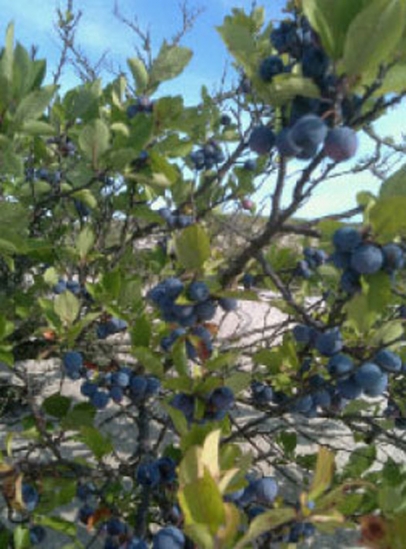Stalking the Elusive Beach Plum
There are plenty of wild foods to pick on the Cape, and the best part—other than the eating part—is the expedition out to pick them. These are delicacies in places rarely visited because of their remoteness or difficulty to access: cranberries in fall, wintergreen berries in winter, dewberries in early summer, blueberries in July and finally the king of fruit—beach plums—in August!
The small stand of beach plum bushes in our yard have looked ready for a week. They are my indicator for when it’s time to head to my secret spots. Green, red and purple fruit all at once. I must get out to pick soon. They won’t wait for me!
It’s mid August and time to pick, but it was last spring when great white flower torches rose from the otherwise unremarkable, low, leafless shrubs. The flowers are covered with masses of tiny bee-like syrphid flies, sometimes called hover flies or flower flies, busily sipping nectar like little hummingbirds.That’s when you get out and locate beach plum bushes, before they leaf out and blend in.
They are found growing randomly around the Cape roadsides, parking lots, backyards and the backsides of sand dunes. Spring is the time to hunt them down and mark your territory for later picking. You’ll find them wild and gnarly in the most unsuspecting places. You don’t expect to find them in heavily populated areas; many have been cut down and replaced with non-native ornamentals (in need of special care and irrigation). But a few homeowners recognize their value as a fruiting shrub and the importance of keeping the Cape’s pine barren lands healthy by choosing native flowering plants that are good sources of nectar and pollen for pollinating insects like the honey and bumble bees, and so have spared them. And then there are the real unlikely places like the Stop & Shop in Yarmouth that has so cleverly landscaped with them. Free food in the parking lot! What a novel idea! It’s a great ornamental as well, with springtime color and fall fruit. It thrives in poor soil, with little water—a landscaper’s dream.
It’s off to my favorite secret spot to pick: early morning race to the beach to get on the back dunes before anyone sees me at five o’clock. In the hollow of the August dunes one would imagine a scorching heat, but a whirlwind of breezes swirls past leaving little half-circles etched in the sand below the dune grasses. There’s no one here but me, except perhaps a few sleepy foxes napping in their dens or an occasional bird in the bush. Silence prevails, the Hudsonia tormentosa is still fresh blue-green, the beach grass has dried beige tips. The sun is rising. I will be here until sunset when I can carry my baskets out unnoticed.
The bushes are dripping with beach plums. I greedily cup both hands around a branch and strip off handfuls of fat, succulent fruit. Some so ripe that they taste like what they are: plums. You need to pick all color berries for a perfect jelly: red, green and purple. I pick all day. It is a good berry year.
Poison ivy, brambles and hot sand are my biggest hazards. I walk far into the dunes filling basket after basket, climbing dune after dune. It is getting late in the afternoon now, and the sun is beginning to lower. I rest for lunch in the little shade cast by a beach plum bush cascading from a high dune. The sky is azure blue with billowing white cumulus clouds very slowly drifting by. A spider drops down on a thread; hundreds of swallows are flying past overhead.
The walk back at the end of the day is not for the faint of heart. It’s easily 30 pounds of berries I’ve got in my backpack, gunny bag and basket, along with my cooler, change of clothes, towel and jug of water. I have to stop and rest as I trudge up and down the many dunes I’ve crossed during my trek. It seems forever before I reach my truck and set off for home.
My mother makes the jelly, enough to last until next August. It’s the only jelly we like. She says she’s always done it the “simple” way and not the “right” way. I’ll tell you I don’t know how it would get any better. This is her recipe:
Use a few green beach plums, but basically half red and half ripe and purple. Cover the fruit with water and cook until they are soft. Mash them, then put through a sieve. In a big pot put one cup juice to one cup sugar (but don’t mix more than four cups of juice to the sugar at a time or it may boil over) and bring to a rolling boil. After it has been boiling for a few minutes, scoop up a little juice in a metal spoon and tip the spoon.
When the liquid beads together and forms one drip off the tip of the spoon, it’s ready to pour into sterilized, hot jars laid out on a wet towel. This is the tricky part: too long cooking and the jam will harden to the spoon. You can then pour a layer of paraffin wax on top and cover with your jelly jar cap.
Don’t forget to stake out your beach plums next spring!





